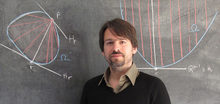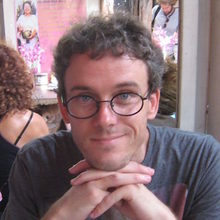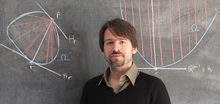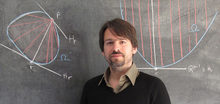Past Events
[Geometry, Topology and Dynamics Seminar] Non-smoothable bundles and gauge theory for families by Dr. Hokuto Konno (Riken)
2019-05-23Abstract: It is known that there exist many "non-smoothable 4-manifolds", that is, topological 4-manifolds which do not admit smooth manifold structures. Gauge theory provides a strong tool to detect such interesting topological 4-manifolds. In this talk, I will explain a family version of this story. Namely, I will show that a family version of gauge theory may detect "non-smoothable 4-manifold bundles", which is a fiber bundle whose structure group is the homeomorphism group of a 4-manifold, but we cannot reduce the structure group into the diffeomorphism group. This is joint work with David Baraglia and with Tsuyoshi Kato and Nobuhiro Nakamura.
Mini Symposium: Computational Problems in Low-dimensional Topology II
2019-04-16 to 2019-04-18Computational Problems in Low-dimentional Topology II
Venue: Conference Room 1&2
[Geometry, Topology and Dynamics Seminar] Robust chaos: a tale of blenders, their computation, and their destruction by Dr. Hinke Osinga (University of Auckland)
2019-03-27A blender is an intricate geometric structure of a three- or higher-dimensional diffeomorphism. Its characterising feature is that its invariant manifolds behave as geometric objects of a dimension that is larger than expected from the dimensions of the manifolds themselves. We introduce a family of three-dimensional Hénon-like maps and study how it gives rise to an explicit example of a blender. The map has two saddle fixed points. Their associated stable and unstable manifolds consist of points for which the sequence of images or pre-images converges to one of the saddle points; such points lie on curves or surfaces, depending on the number of stable eigenvalues of the Jacobian at the saddle points. We employ advanced numerical techniques to compute one-dimensional stable and unstable manifolds to very considerable arclengths. In this way, we not only present the first images of an actual blender but also obtain a convincing numerical test for the blender property. This allows us to present strong numerical evidence for the existence of the blender over a larger parameter range, as well as its disappearance and geometric properties beyond this range. We will also discuss the relevance of the blender property for chaotic attractors; joint work with Stephanie Hittmeyer and Bernd Krauskopf (University of Auckland) and Katsutoshi Shinohara (Hitotsubashi University).
[Geometry, Topology and Dynamics Seminar] Global manifolds and the transition to chaos in the Lorenz system by Dr. Bernd Krauskopf (University of Auckland)
2019-03-26The Lorenz system still fascinates many people because of the simplicity of the equations that generate such complicated dynamics on the famous butterfly attractor. This talk addresses the role of the stable and unstable manifolds in organising the dynamics more globally. A main object of interest is the stable manifold of the origin of the Lorenz system, also known as the Lorenz manifold. This two-dimensional manifold and associated manifolds of saddle periodic orbits can be computed accurately with numerical methods based on the continuation of orbit segments, defined as solutions of suitable two-point boundary value problems. We use these techniques to give a precise geometrical and topological characterisation of global manifolds during the transition from simple dynamics, via preturbulence to chaotic dynamics, as the Rayleigh parameter of the Lorenz system is increased; joint work with Hinke Osinga (University of Auckland) and Eusebius Doedel (Concordia University, Montreal).
Visit: Prof. Bernd Krauskopf and Prof. Hinke, University of Auckland
2019-03-23 to 2019-03-29Visit: Prof. Bernd Krauskopf and Prof. Hinke, University of Auckland
[Geometry, Topology and Dynamics Seminar] Tropical geometry, normal surfaces and the character variety by Stephan Tillmann (University of Sydney)
2019-03-22[Geometry, Topology and Dynamics Seminar] Tropical geometry, normal surfaces and the character variety by Stephan Tillmann (University of Sydney)
[Geometry, Topology and Dynamics Seminar] Topology on tiny machines: logspace and finite-state complexity by Ben Burton (University of Queensland)
2019-03-20[Geometry, Topology and Dynamics Seminar] Topology on tiny machines: logspace and finite-state complexity by Dr. Ben Burton (University of Queensland)
[Geometry, Topology and Dynamics Seminar] Essential surfaces detected by the character variety by Stephan Tillmann (University of Sydney)
2019-03-19[Geometry, Topology and Dynamics Seminar] Essential surfaces detected by the character variety by Stephan Tillmann (University of Sydney)
[Geometry, Topology and Dynamics Seminar] Character varieties, ideal points and actions on trees by Stephan Tillmann (University of Sydney)
2019-03-18[Geometry, Topology and Dynamics Seminar] Character varieties, ideal points and actions on trees by Dr. Stephan Tillmann (University of Sydney)







